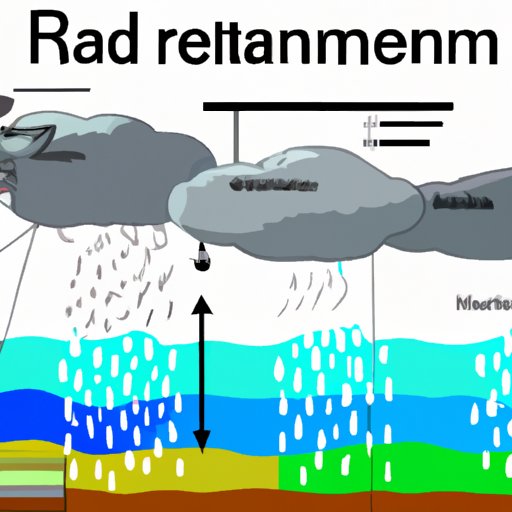Introduction
Rain is one of nature’s most common phenomena, and it is essential for life on Earth. But have you ever wondered why it rains? Can your science explain why it rains? This article aims to help answer this question by exploring the science behind rainfall.

Exploring the Science Behind Rainfall
To understand why it rains, we must first explore the science behind rain. Rain is a form of precipitation, which occurs when water vapor condenses into tiny droplets or ice crystals and falls from the atmosphere. To explain this process, we must look at both the physics and the chemistry of rain formation.
How Do We Explain Rain?
In order to explain how rain forms, we must first understand the basics of physics and chemistry. According to Dr. John Abraham, professor of thermal sciences at the University of St. Thomas, “Rain is created when water vapor rises into the atmosphere, cools and condenses into tiny droplets or ice crystals. These droplets then fall back down to the earth’s surface as rain.”
Investigating the Physics of Precipitation
The physics of rain formation involve the transfer of energy from the sun to the atmosphere. When the sun’s energy reaches the Earth’s surface, it warms the land and ocean surfaces. This causes the air above them to become warmer and lighter, causing it to rise and cool. As the air rises, it expands and cools even further, until it reaches an altitude where its temperature is below the dew point. At this point, the air can no longer hold the amount of water vapor it contains, and it condenses into droplets or ice crystals, forming clouds.
Examining the Chemistry of Rain Formation
The chemistry of rain formation involves the interaction between the water molecules and other chemicals in the atmosphere. As the water vapor rises, it encounters other chemicals such as dust particles, salt, and sulfur dioxide. These chemicals act as nuclei, or centers, around which the water molecules can gather and form droplets or ice crystals. The droplets or crystals then grow larger and heavier until they fall from the clouds as rain.
The Role of Atmospheric Pressure in Rainfall
In addition to the physics and chemistry of rain formation, atmospheric pressure also plays an important role. Atmospheric pressure is the force exerted by the weight of the air in the atmosphere. When the atmospheric pressure is high, the air is more stable and less likely to rise and form clouds. On the other hand, when the pressure is low, the air is less stable and more likely to rise and form clouds, resulting in rain.
The Hydrological Cycle and Rainfall
The hydrological cycle is the continuous movement of water throughout the Earth’s environment. Water evaporates from the land and ocean surfaces, forming clouds, which eventually produce rain. This rain replenishes the water reserves on land and in the oceans, which are then evaporated again, completing the cycle.
Meteorology and the Causes of Rainfall
Meteorology is the study of the atmosphere and its processes. Meteorologists study the various factors that affect the atmosphere, including air pressure, temperature, humidity, and wind. By studying these factors, meteorologists can determine what type of weather will occur and when it is likely to occur. For example, if the atmospheric pressure is low, there is a greater chance of rain.
Conclusion
In conclusion, we have explored the science behind rainfall. We have seen that the physics and chemistry of rain formation involve the transfer of energy from the sun to the atmosphere, as well as the interaction between water molecules and other chemicals in the atmosphere. We have also examined the role of atmospheric pressure in rainfall, as well as the hydrological cycle and meteorology. With this knowledge, we can now better understand the science behind why it rains.
Summary of Key Points
Rain is a form of precipitation that occurs when water vapor condenses into tiny droplets or ice crystals and falls from the atmosphere. The physics and chemistry of rain formation involve the transfer of energy from the sun to the atmosphere, as well as the interaction between water molecules and other chemicals in the atmosphere. Atmospheric pressure also plays an important role in rainfall, as does the hydrological cycle and meteorology.
Final Thoughts on Solving the Problem
We now have a better understanding of why it rains. While we may not be able to control the weather, we can appreciate the beauty of rainfall and the vital role it plays in sustaining life on Earth. By learning more about the science of rain, we can gain a deeper appreciation for this natural phenomenon.
(Note: Is this article not meeting your expectations? Do you have knowledge or insights to share? Unlock new opportunities and expand your reach by joining our authors team. Click Registration to join us and share your expertise with our readers.)
